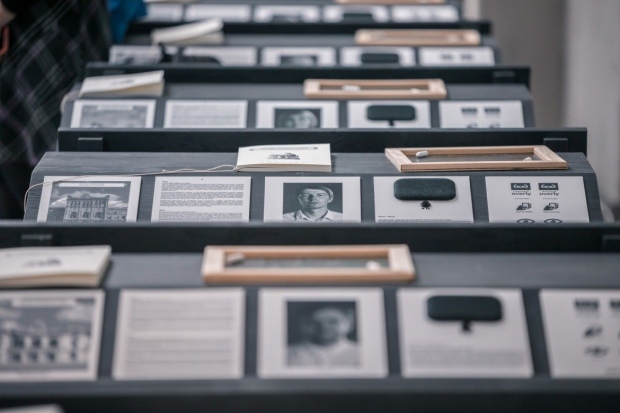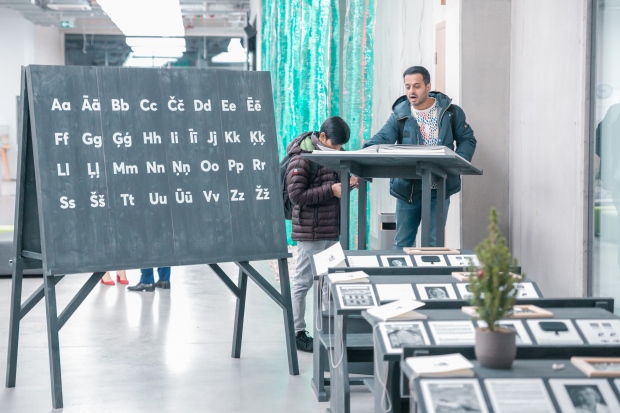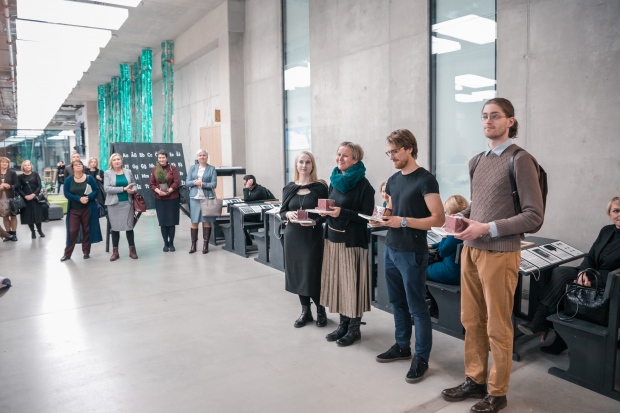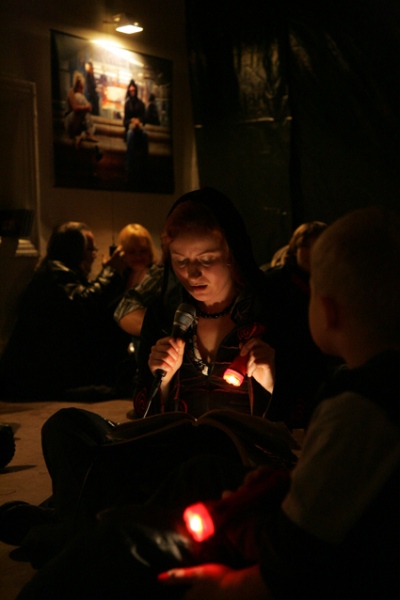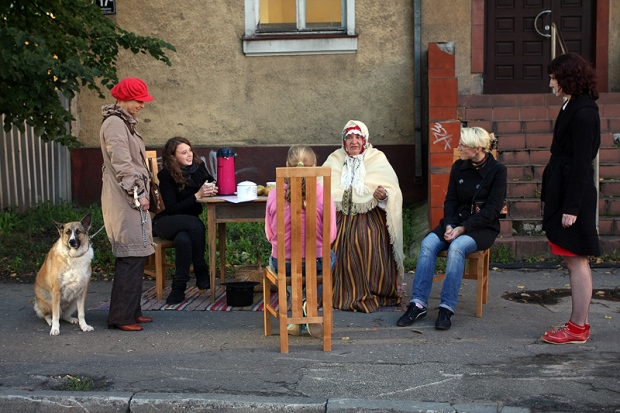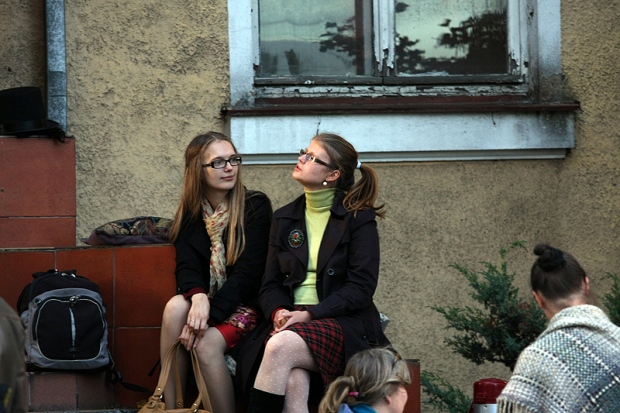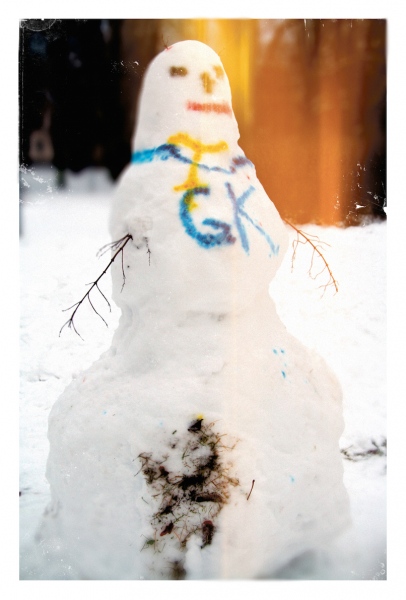Sarunas ar kokiem / Conversations with Trees (2024)
The participatory performance "Conversations with Trees" by Krista Burāne and Kristīne Brīniņa, was an opening event for the literature festival Punctum. The participatory performance "Conversations with Trees" took place on May 14 from 12:00 to 1.00 pm in Linden Alley, opposite the Cabinet of Ministers of Latvia, during the scheduled Cabinet meeting. The performance was not a protest against any of the issues on the meeting’s agenda, but is a reminder that every decision made will affect people and therefore, in a more direct or indirect way, other living beings, including trees. In Latvia, the attitude towards nature is characterized by anthropocentric approach which tends to dominate over nature, consuming and subjugating it. This was observed both in the amendments of the Cabinet of Ministers on forest cutting that were canceled by the Constitutional Court, and in the fact that country’s biologically diverse and old forests are still not protected by law. In legal texts and in the minds of many, trees are seen as cubic meters that have to bring economic benefit, and the lives of trees are given a relatively high price but little value. The consequence of such an attitude is the very poor and endangered state of nature's health in Latvia, as evidenced by the data of the Natural Register. The participants of the participatory performance gathered by the 136 Linden trees of the alley and devoted their time and attention to the trees. The performance was a public gesture that expressed interest and care for the life of a tree. Riga's central street literally became a meeting place for trees and people, where people were not afraid to see a tree as a living being, talk to it, know what they wanted to say to it and hear the answer.









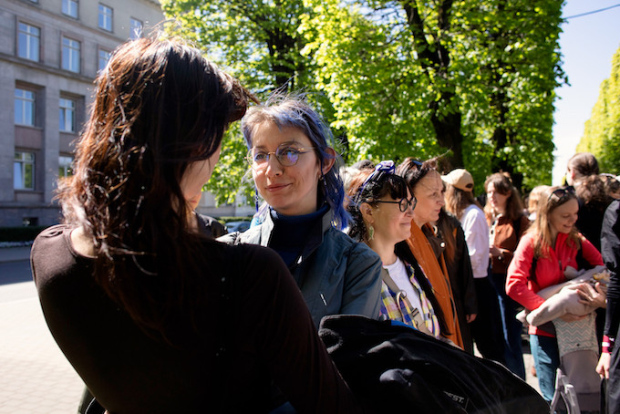























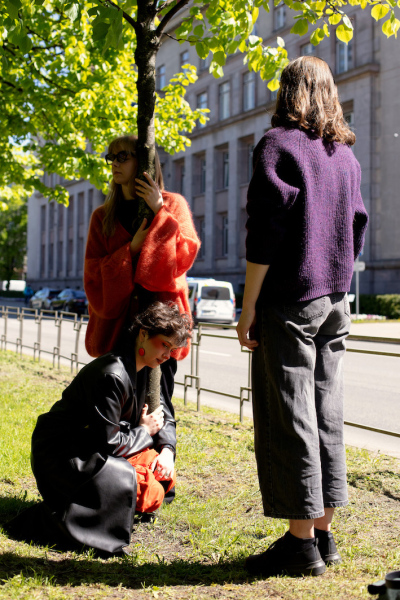






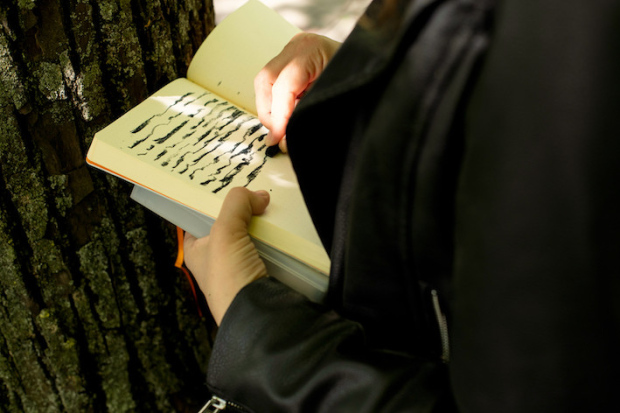



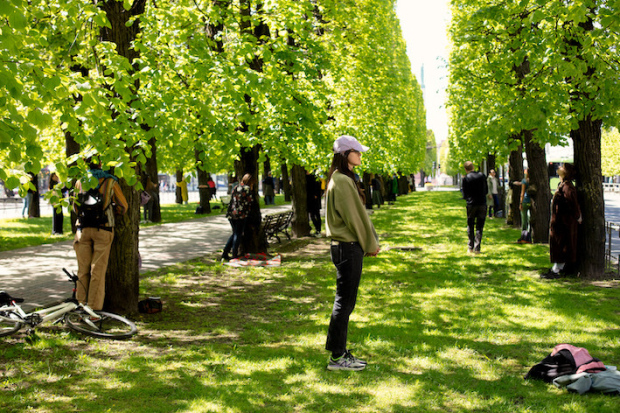



























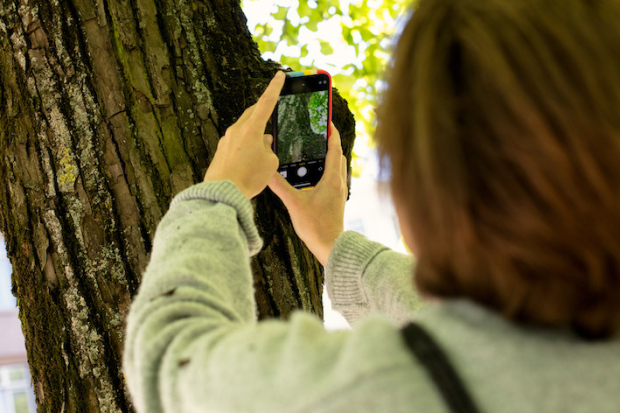



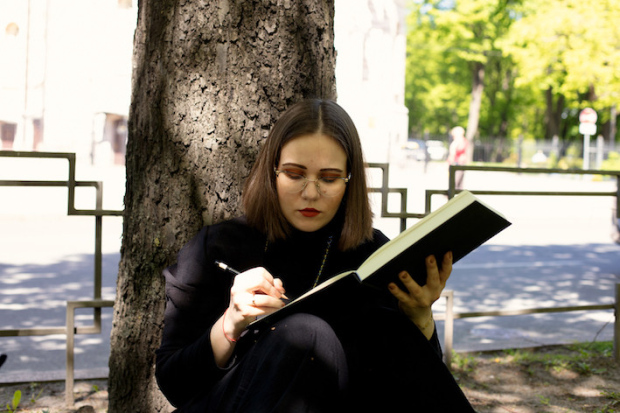






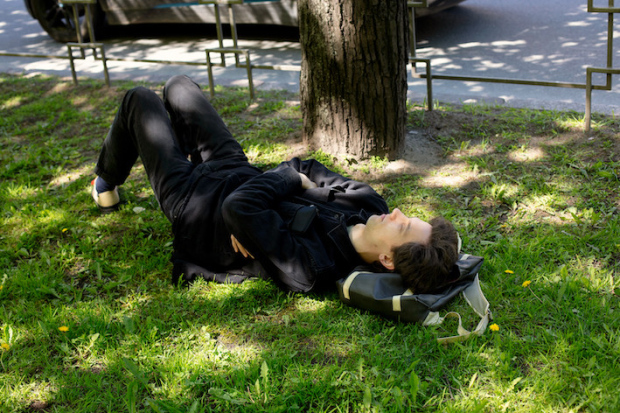













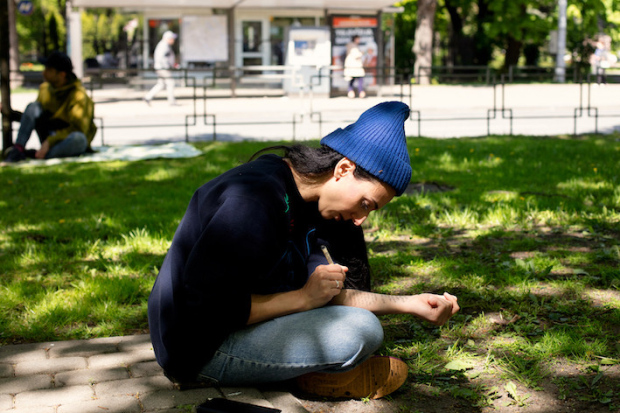




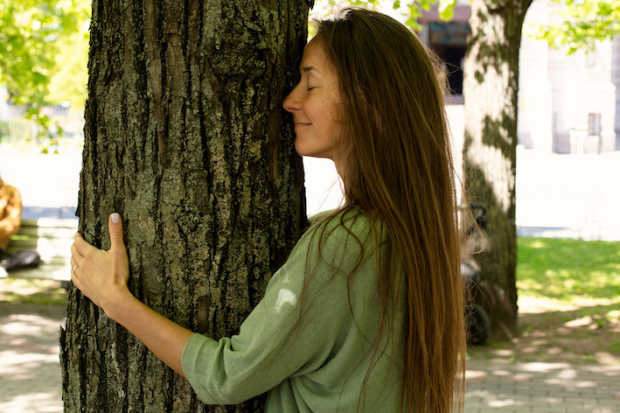







- 1
- 2
- 3
- 4
- 5
- 6
- 7
- 8
- 9
- 10
- 11
- 12
- 13
- 14
- 15
- 16
- 17
- 18
- 19
- 20
- 21
- 22
- 23
- 24
- 25
- 26
- 27
- 28
- 29
- 30
- 31
- 32
- 33
- 34
- 35
- 36
- 37
- 38
- 39
- 40
- 41
- 42
- 43
- 44
- 45
- 46
- 47
- 48
- 49
- 50
- 51
- 52
- 53
- 54
- 55
- 56
- 57
- 58
- 59
- 60
- 61
- 62
- 63
- 64
- 65
- 66
- 67
- 68
- 69
- 70
- 71
- 72
- 73
- 74
- 75
- 76
- 77
- 78
- 79
- 80
- 81
- 82
- 83
- 84
- 85
- 86
- 87
- 88
- 89
- 90
- 91
- 92
- 93
- 94
- 95
- 96
- 97
- 98
- 99
- 100
- 101
- 102
- 103
- 104
- 105
- 106
- 107
- 108
- 109
- 110
Latvijas kultūras alfabēts /Alphabet of Latvian Culture (2019)
Audiovizuālā instalācija "Latvijas kultūras alfabēts" tapusi, atzīmējot Latvijas nacionālo kultūras, izglītības un zinātnes institūciju 100. gadadienu, kas iekļauta UNESCO svinamo gadadienu sarakstā. Izstāde bija skatāma Parīzē UNESCO centrālajā mītnē un Latvijā - Latvijas Universitātē, Latvijas Nacionālajā bibliotēkā un citur.
Izstāde stāsta par septiņām, 1919. gadā dibinātajām, nacionālajām kultūras, izglītības un zinātnes institūcijām – Latvijas Nacionālo teātri, Latvijas Mākslas akadēmiju, Jāzepa Vītola Latvijas Mūzikas akadēmiju, Latvijas Nacionālo bibliotēku, Latvijas Nacionālo arhīvu, Latvijas Universitāti un Latvijas Nacionālo operu un baletu.
Izstādes idejas autore Krista Burāne: "Septiņu mākslas, izglītības un zinātnes nacionālo institūciju darbība simts gadu griezumā ir radījusi mūsdienu Latvijas kultūras valodu. Kā zināms, valodas pamatā ir alfabēts, kura apgūšanai tiek lietota Ābece. Tāpēc instalācijas centrā atrodas grāmata "Latvijas kultūras ābece". Tā tapusi iedvesmojoties no 1919. gada ābeču paraugiem, bet vēsta par Latvijas kultūras šodienu un nākotni. Ābece ietver 106 šķirkļus, kas stāsta par procesiem mūsdienu Latvijas kultūrā un cilvēkiem, kuru dzīves un darbs ir saistīts ar septiņām simtgadi svinošajām institūcijām. Daļu no ierakstiem, par kuriem signalizē tematiskas ikonas uz septiņiem 1919. gada stilistikā veidotiem skolas soliem un grāmatas lappusēs, ir iespējams aplūkot paplašinātā digitālā formātā katra lasītāja viedierīcē, lejuplādējot latviešu izstrādāto programmu "Overly". Ikonas ved uz videointervijām ar septiņām spilgtām personībām - Katrīnu Neiburgu, Aleksandru Antoņenko, Ivetu Apkalnu, Valteru Sīli, Māru Sprūdžu, Silviju Tretjakovu, Jāni Karušu. Viņu balsīs izskan arī latviešu valodas alfabēts, aicinot katru izstādes apmeklētāju domāt par to, kādas vērtības viņš var radīt, izmantojot mūsu 33 burtus."
Izstādes idejas autore ir Krista Burāne, tās dizainu un scenogrāfiju veidojis Rūdolfs Baltiņš, savukārt izstādes centrālā elementa - grāmatas "Latvijas kultūras ābece" autores ir Krista Burāne un Laila Burāne, bet ilustrators – Reinis Gailītis. Izstādes veidošanā piedalījās operators – Dainis Juraga, skaņu režisors – Artis Dukaļskis, video pēcapstrāde – Mārtiņš Kontants, audio risinājumu veidotājs - Guntis Maisaks, "Solavi", galdnieks – Jānis Kaličus, tehniskie palīgi – Gatis Tillers un Atis Erics, tehnisko atbalstu sniedza Oskars Plataiskalns un "Dekorāciju darbnīca".
Izstāde un grāmata tapusi Latvijas valsts simtgades programmā, atzīmējot Latvijas nacionālo kultūras, izglītības un zinātnes institūciju 100. gadadienu, kas iekļauta UNESCO svinamo gadadienu sarakstā.
On the occasion of the 100th anniversary of Latvian National Institutions for Culture, Education and Science included among the anniversaries to be associated with UNESCO in 2018-2019 the audio visual installation “Alphabet of Latvian Culture” was opened at UNESCO Headquarters in Paris, France. The Anniversary unites 7 institutions, namely: National Theatre of Latvia; Art Academy of Latvia; Jazeps Vitols Latvian Academy of Music; Latvian National Library; National Archives of Latvia; University of Latvia; Latvian National Opera and Ballet to celebrate the important intellectual contribution the institutions have invested in the formation of Latvian cultural identity and its continuous enrichment over the years.
“The foundation-stone of the language of Latvian culture is the action of national institutions which promote culture, education and sciences. The foundation of any language is alphabet, it is explained through a textbook called ABC which will be the central theme of the exhibition “Alphabet of Latvian Culture”. Each letter in Latvian alphabet is introduced through an ABC entry on processes within the anniversary institutions or through a story about a person related to the institutions concerned,” points out author of exhibition idea artist Krista Burāne.
The Exhibition includes 7 stands introducing all anniversary institutions, as well as a textbook “The ABC of Latvian Culture” which is written by Krista Burāne and Laila Burāne. The textbook is illustrated by Reinis Gailītis. Design of exhibition is developed by Rūdolfs Baltiņš, director of photography is Dainis Juraga and sound engineer is Artis Dukaļskis. The Exhibition is created as a part of the Latvian Centenary programme, it is organized by the Latvian National Commission for UNESCO and the Ministry of Culture of the Republic of Latvia in close cooperation with the Permanent Delegation of the Republic of Latvia to UNESCO, as well as 7 national institutions for culture, education and science.
Exhibition was opened for visitors from 21st of October till the 25th of October, 2019 at Hall Segur in UNESCO Headquarters, 7, Place de Fontenoy, Paris, France. After that exhibition was opened at University of Latvia and will trvale to several places of Latvia.
Pasakas par bezmiegu / Tales about an insomnia (2007, 2016)
This project was made while I was in artists residence in Paris 2007. I went out in city streets in late nights wearing pajama, with pillow and lamp, stopped the people and told them that I can’t sleep. Then I asked them to sing me a lullaby. I recorded singing, then make photos with them and after wrote a fairy tale about each of stranger.
I was seeking for the tenderness and feeling of safety in the big city life, for people who can give a peaceful state of mind similar to I had in childhood nights when listening to lullabies.
All materials (12 large scale photos, lullabies, fairy tales) were exhibited by Latvian Contemporary art center. With the sound (by Andris Indāns), pictures, texts, and all atmospheres my aim was to create the place where spectators could fall to sleep and found the place for rest in the middle of the stressful big city life. And I succeed it! There were people in the exhibition, which at the end of the day was wakened up by museum attendants.
After the Latvian Contemporary art center exhibition hall, the project was shown as a part of "Paris spring" month in the Univesity of Latvia.
http://www.lcca.lv/lv/aktualitates/kristas-buranes-izstade-pasakas-par-bezmiegu/
In spring 2016 the "Tales of insomnia" had possibility to start his second life and was exhibited in three Latvia schools as a part of project "Small school bag of culture"
Atmiņu istabas / Rooms of memories (2012)
Nomination for award "1 kg culture" as "A most surprising culture project" 2012
"Rooms of memories" was built in the old and empty house were the first memorial exhibition of a live actor Leons Leščinskis was made to tell the story about his and at the same time our lives in the last 50 years of 20 century.
The project consist from an exhibition, performances based on the play by S. Becket "Krapp's last tape" and reconstructions of 9 most important performances in Latvian theater history.
Authors - Krista Burāne, Mārtiņš Eihe (creative association Nomadi)
Director - Mārtiņš Eihe
Script - Krista Burane, Leons Leščinskis
Sound instatlations - Edgars Rubenis
Setdesign - Māris Ruskulis
Actor - Leons Leščinskis
Reconstructions of historical performances - students of the Latvia Academy of Culture.
Pelēkā asfalta stāsti /The stories of gray asphalt (2010)
This event was the part of contemporary art festival “Survival kit 2010” produced by Latvia Contemporary art center. For one week I together with Martins Eihe recreated the E. Birznieka Upisa street in Riga in place people could meet for telling, listening, watching, writing, showing stories about beeing in a city. We had
- Street stories told by more than fifty different storytellers. They were sitting all along the street on sidewalks and asking people to join them and listen to stories, to retell stories and share them. Storytellers were people from the community of the street, well - known writers and poets, people from a countryside and other cities.
- Sky stories told from the tower of one of the street house. Everyone who wanted got the possibility to tell his / here story in between the sky and earth to all city.
- Sidewalk stories were written by young ply writers on the both sidewalks of the street. Every day they wrote new stories because the old once was gone because of rain or there was deleted by street cleaners.
- The Invisible theater created different situations on the street about socially important themes (abortion, drugs, crime, suicides, national hatred etcetera ) . Actors played these situations but spectators didn’t know that what they see is theater. The aim was to create situations, which could be the reason for spectators to start to speak about them at home, work, with friends.
- Photo stories with 100 photos were made about every house on that street during all a day. As a pattern I used geographic and time map, but the content comes from the stories told on the street. These were staged photos were imagination was combined with documental life.
- Music stories were told by street musicians of Riga which we asked to come to our street for that one-week and be a part of our performance.
The main aim of that project was to create situations people start to speak about. With friends and strangers. About their life’s and about what they can learn from each other - some surviving strategies for living in cities. About stopping their run for a while, sit, to have a cup of tea and think about themselves.
To create this event we involved inhabitants of the street, cafes, shops and houses owners who were so kind and let us use they places and properties, and become storytellers.
Rīgas raganas / Witches of Riga (2008)
"Witches of Riga" was the performance in the photographies. 70 documentary b/w photos about the everyday life of five Riga street sweepers were arranged on the base of play "Witch of Riga" by Rainis. This play tells the story of conquest of Riga by tsar Peter I and the young witch who tried to save the lives of Riga citizens in 1710. The exhibition was held in the authentic 17. - 18 century house and portraits of Riga street sweepers were made in the style of pictorial art of that time.
The texts of play and documental photos were exhibited in the large "witches books", but under the fictional portraits on the historical walls spectators could read documantal stories about real heroes of the exhibition.
My aim was to smash the distance between centuries and tell the story about the strength of women.
Exhibited at - Riga History muséum, Ventspils muséum, Cēsu muséum, Liepaja gallery of art.
Sniegavīru rendezvous /Snowman's rendezvous (2006)
I opened the world's first dating office for snowmens in Riga Literature Museum in the winter 2006 . Anyone who wanted to have a cool friend could get him / her with dating service Snowmens RENDEZVOUS help.
The nesecety to open the office was determined by the fact that numbers of homless snowmens in Riga was growing rapidly. They - big and small, joufull and angry, frigele and strong were standing in Riga districts (Bolderaja, Purvciems, Imanta, Zolitude, Pardaugava, Teika, Jugla) Old Town courtyards, parks and gardens.
They stood where felted, they look at how people live, the way we speak, laugh and sometimes even love.
Snowmens yearning, they know that somewhere must be someone with whom they can talk about the geometry of snowflakes and astronomy, about sex when outdoors minus twenty and how to prepare himself for spring. Perhaps they even do not care to talk about, they just want to meet. And then we will see what happen. Maybe even a date, maybe even love, which is stronger than the snow.
There were snowman portraits, created by Krista Burāne (photos) and Sandijs Ruļuks (digital post production) as well as read snowman dating ads, which were written by poets Marts Pujāts, Anna Auziņa Sergejs Timofejes, Agnese Krivade, Pēteris Draguns, Inga Gaile, Ilmārs Šlāpins, Andra Manfelde , Rihards Bargais, Rimands Ceplis, Kārlis Vērdiņš, Reinis Tukišs, Inese Zandere, Krista Burāne in Snowmans dating office.
Sowmens "dance" sounds was created by Andris Indāns and Edmunds Ansons.
Dating Office database with portraits, love poetry and dating advertisements was published in
1) the postcard format book by Jānis Roze publishing house for all who wish to be able to keep his / her friend sweet face in pocket, or to send it to grandmother to the countryside, where the Riga snowmens are in a great rarity.
2) dating and social sites on internet.






















